Online discussion
In Conversation: Christine Eyene, Evan Ifekoya, Corey Mwabma & Elvira Dyangani Ose
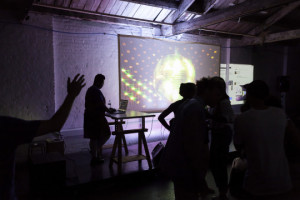
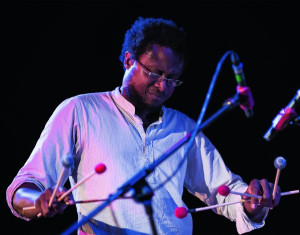
Dr. Corey Mwamba is a musician, promoter, arts advocate, and researcher from Derby committed to jazz and improvised music in Britain and Ireland. Mwamba predominantly plays vibraphone; he also plays dulcimer and uses audio processing software. He is recognised as a highly creative improviser and composer working across a wide range of jazz and contemporary music with a distinctive approach and tone: a potent blend of pure sound, highly melodic phrases and ethereal textures; barely whispered chords and ear-piercing robotic screams.
Mwamba is the current presenter of Freeness, a weekly show on BBC Radio 3 that plays adventurous jazz and improvised music from across the globe. Mwamba was granted an AHRC studentship for a Master of Research degree in Music at Keele University in 2014, and was recently awarded a doctorate in Jazz Research at Birmingham City University. He is also an active advocate of the arts and adventurous programmer of new music in Derby.
Photo: Agata Urbaniak.
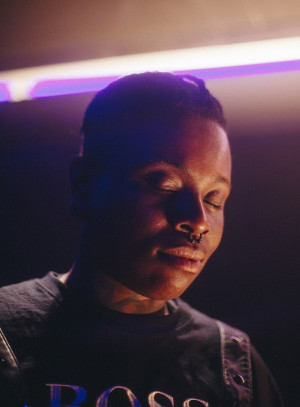
Evan Ifekoya is an artist and energy worker who through sound, text, video and performance places demands on existing systems and institutions of power, to recentre and prioritise the experience and voice of those previously marginalised. Through archival and sonic investigations, they speculate on blackness in abundance; the body of the ocean a watery embodied presence in the work.
*They established the collectively run and QTIBPOC (queer, trans, intersex, black and people of colour) led Black Obsidian Sound System (B.O.S.S.) in 2018. They have presented exhibitions and performances in the UK and Internationally including: Liverpool Biennial (2021); De Appel Netherlands (2019); Gasworks London (2018) Contemporary Arts Centre New Orleans as part of Prospect 4 (2017); Stevenson Gallery, Cape Town (2016); Studio Voltaire London (2015) and Castlefield Gallery Manchester (2014).**
Photo: Kevin Osepa
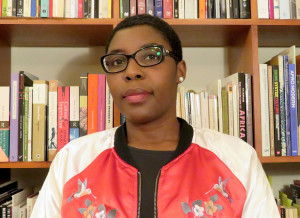
Christine Eyene is a Research Fellow in Contemporary Art at the University of Central Lancashire where she is part of Making Histories Visible, an interdisciplinary visual arts research project led by the artist and Professor of Contemporary Art Lubaina Himid CBE RA. She is the Artistic Director of the Biennale Internationale de Casablanca (BIC) and her current academic research is focused on the practice of South African photographer George Hallett (1942-2020) with a particular interest in its links with African literature and South African jazz music. Her other research interests include: feminist art practices, digital media, design, music, urban culture, and socially-engaged initiatives.
Sound art projects include Sounds Like Her: Gender, Sound Art and Sonic Cultures, a New Art Exchange UK touring exhibition (2017-2020) and publication; Résonances: Second Mouvement, Espace Croix-Baragnon, Toulouse, as part of Printemps de Septembre (2016); Curators’ Series # 8: All Of Us Have A Sense Of Rhythm, David Roberts Art Foundation, London (2015). She is currently developing Belgian sound art festival OORtreders’ first Curating Lab (23-25 October 2020), in the framework of Sounds Now, a Creative Europe project.
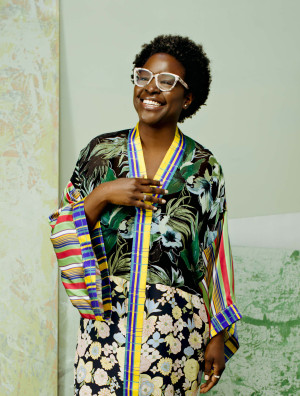
Elvira Dyangani Ose is Director of The Showroom, London. She is currently affiliated to the Department of Visual Cultures at Goldsmiths, the Thought Council at the Fondazione Prada and Tate Modern Advisory Council. Until November 2018, she served as Creative Time Senior Curator, where she most recently curated their 11th edition of their Summit. She is currently curating the publications of 34th Bienal De São Paulo and is the Curator for the PHotoESPAÑA, International Festival of Photography and Visual Arts.
Dyangani Ose was Curator of the eighth edition of the Göteborg International Biennial for Contemporary art, (GIBCA 2015) and Curator International Art at Tate Modern (2011 – 2014). Ose has published and lectured on modern and contemporary African art and has contributed to art journals such as Nka and Atlántica. She studied a Doctoral Degree in History of Art and Visual Studies at Cornell University, New York; has a MAS in Theory and History of Architecture from Universitat Politècnica de Catalunya, Barcelona; and a BA in Art History from Universitat Autònoma de Barcelona.
Photo: Christina Ebenezer
SONIC CULTURES: Curator and critic Christine Eyene, multimedia artist Evan Ifekoya and IN·FLO·RES·CENCE composer, vibraphonist and researcher Corey Mwabma, in conversation with The Showroom Director Elvira Dyangani Ose about the cross-modality of music, aesthetics, and culture.
This discussion includes a welcome by curator Katherine Finerty to IN·FLO·RES·CENCE’s focus on the cross-modality of art and sound, followed by Elvira Dyangani Ose’s introduction of the three speakers including: one of the project’s commissioned composers, Dr. Corey Mwamba (a musician, promoter, arts advocate, and researcher from Derby); Evan Ifekoya (a London-based artist and energy worker who practices through sound, text, video and performance) and Christine Eyene (a UK-based curator and critic focusing on feminist art practices, digital media, design, music, urban culture, and socially-engaged initiatives).
This conversation delves into different sound art projects; ideas of polyrhythmic cultural expression; challenging hierarchical Western creative philosophies and methods; and the exchange between identity formation and sonic landscapes, which all of the participants’ practice powerfully, yet quite distinctly, address.
It starts by reflecting on Corey Mwamba’s composition fellowred as a framework of how to communicate and connect with people during these trying times of absence – about how to find a deep intimacy of communication and companionship. In response Christine Eyene discusses absence with reference to her projects around sound to fill a void of the representation black experience; in context to her personal reconnection with cultural heritage; and upon reflection of the recent loss South African photographer George Hallett. Evan Ifekoya also reflects on her relationship to sound as similarly in response to what isn’t present or visible, which often manifests in a practice expanding on the subjectivities of being a queer, nonbinary, black, artist.
The discussion continues to talk about the body as a locality for sound; the role of technology in producing and receiving resonance; the politics of sound, from community-led sound systems, radical archiving, and contemporary sound-driven resources; challenging institutional spaces and what it means to be heard; and restructuring voice and sound to amplify conversation and visibility.